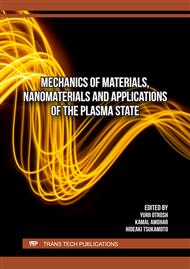[1]
Khalil NZ, Johanne MF, Ishak M. Influence of Al2O3 nanoreinforcement on the adhesion and thermomechanical properties for epoxy adhesive. Compos Part B Eng 2019;172:9–15.
DOI: 10.1016/j.compositesb.2019.05.007
Google Scholar
[2]
Alies MSI, Khalil NZ. Effect of alumina/graphene hybrid nano reinforcement to the adhesion and mechanical properties of adhesively bonded aluminum alloy with epoxy. Mater Today Proc 2022;51:1437–43.
DOI: 10.1016/J.MATPR.2021.12.087
Google Scholar
[3]
Kong N, Khalil NZ, Fricke H, Papadopoulos A. Moisture Absorption Behavior and Adhesion Properties of GNP/Epoxy Nanocomposite Adhesives 2021.
DOI: 10.3390/polym13111850
Google Scholar
[4]
Chen H, Na J, Wang D, Kong D, Zhang X. Numerical simulation and failure experiment of hygrothermal aged CFRP single and double lap joints. Thin-Walled Struct 2023;188:110786. https://doi.org/.
DOI: 10.1016/j.tws.2023.110786
Google Scholar
[5]
Her S-C, Chan C-F. Interfacial Stress Analysis of Adhesively Bonded Lap Joint. Materials (Basel) 2019;12.
DOI: 10.3390/ma12152403
Google Scholar
[6]
Shang X, Marques EAS, Machado JJM, Carbas RJC, Jiang D, da Silva LFM. Review on techniques to improve the strength of adhesive joints with composite adherends. Compos Part B Eng 2019;177:107363.
DOI: 10.1016/J.COMPOSITESB.2019.107363
Google Scholar
[7]
Ramaswamy K, O'Higgins RM, McCarthy MA, McCarthy CT. Influence of adhesive spew geometry and load eccentricity angle on metal-composite bonded joints tested at quasi-static and dynamic loading rates. Compos Struct 2022;279:114812.
DOI: 10.1016/J.COMPSTRUCT.2021.114812
Google Scholar
[8]
Marques EAS, da Silva LFM. Joint Strength Optimization of Adhesively Bonded Patches. J Adhes 2008;84:915–34.
DOI: 10.1080/00218460802505275
Google Scholar
[9]
Carbas RJC, da Silva LFM, Andrés LFS. Functionally graded adhesive joints by graded mixing of nanoparticles. Int J Adhes Adhes 2017;76:30–7.
DOI: 10.1016/J.IJADHADH.2017.02.004
Google Scholar
[10]
Yudhanto A, Alfano M, Lubineau G. Surface preparation strategies in secondary bonded thermoset-based composite materials: A review. Compos Part A Appl Sci Manuf 2021;147:106443.
DOI: 10.1016/J.COMPOSITESA.2021.106443
Google Scholar
[11]
Wang X, Zhang Q. Role of surface roughness in the wettability, surface energy and flotation kinetics of calcite. Powder Technol 2020;371:55–63.
DOI: 10.1016/J.POWTEC.2020.05.081
Google Scholar
[12]
Ahmadi Z. Nanostructured epoxy adhesives: A review. Prog Org Coatings 2019;135:449–53.
DOI: 10.1016/J.PORGCOAT.2019.06.028
Google Scholar
[13]
Sul* J-H, Prusty BG, Kelly DW. Molecular dynamics study on effects of aspect ratio of carbon nanotubes in thermosetting epoxy based nanocomposites including modeling of crosslinking process. Adv Manuf Polym \& Compos Sci 2015;1:94–104.
DOI: 10.1179/2055035914Y.0000000009
Google Scholar
[14]
Razavi SMJ, Ayatollahi MR, Nemati Giv A, Khoramishad H. Single lap joints bonded with structural adhesives reinforced with a mixture of silica nanoparticles and multi walled carbon nanotubes. Int J Adhes Adhes 2018;80:76–86.
DOI: 10.1016/J.IJADHADH.2017.10.007
Google Scholar
[15]
Ozun E, Ceylan R, Bora MÖ, Çoban O, Kutluk T. Combined effect of surface pretreatment and nanomaterial reinforcement on the adhesion strength of aluminium joints. Int J Adhes Adhes 2022;119:103274. https://doi.org/.
DOI: 10.1016/j.ijadhadh.2022.103274
Google Scholar
[16]
Khalil NZ, Vajpai SK, Ota M, Ameyama K. Effect of particle size distribution on SiC ceramic sinterability. Funtai Oyobi Fummatsu Yakin/Journal Japan Soc Powder Powder Metall 2017;64.
DOI: 10.2497/jjspm.64.281
Google Scholar
[17]
Khalil NZ, Kong N, Fricke H. The influence of GNP on the mechanical and thermomechanical properties of epoxy adhesive: Pearson correlation matrix and heatmap application in data interpretation. Polym Compos 2024;45:8997–9018. https://doi.org/.
DOI: 10.1002/pc.28390
Google Scholar
[18]
Yetik O, Koçoğlu H, Yıldıran Avcu Y, Avcu E, Sınmazçelik T. The Effects of Grit Size and Blasting Pressure on the Surface Properties of Grit Blasted Ti6Al4V Alloy. Mater Today Proc 2020;32:27–36. https://doi.org/.
DOI: 10.1016/j.matpr.2020.05.512
Google Scholar
[19]
Zhang B, Rane K, Piri M, Goual L. Impact of surface roughness, surface charge, and temperature on sandstone wettability alteration by nanoparticles. Pet Sci 2023;20:2852–63. https://doi.org/.
DOI: 10.1016/j.petsci.2023.04.004
Google Scholar
[20]
Said Z, Sharma P, Sundar LS, Li C, Tran DC, Khoa Pham ND, et al. Improving the thermal efficiency of a solar flat plate collector using MWCNT-Fe3O4/water hybrid nanofluids and ensemble machine learning. Case Stud Therm Eng 2022;40:102448. https://doi.org/.
DOI: 10.1016/j.csite.2022.102448
Google Scholar
[21]
Vicki Wanatasanappan V, Kumar Kanti P, Sharma P, Husna N, Abdullah MZ. Viscosity and rheological behavior of Al2O3-Fe2O3/water-EG based hybrid nanofluid: A new correlation based on mixture ratio. J Mol Liq 2023;375:121365. https://doi.org/.
DOI: 10.1016/j.molliq.2023.121365
Google Scholar


